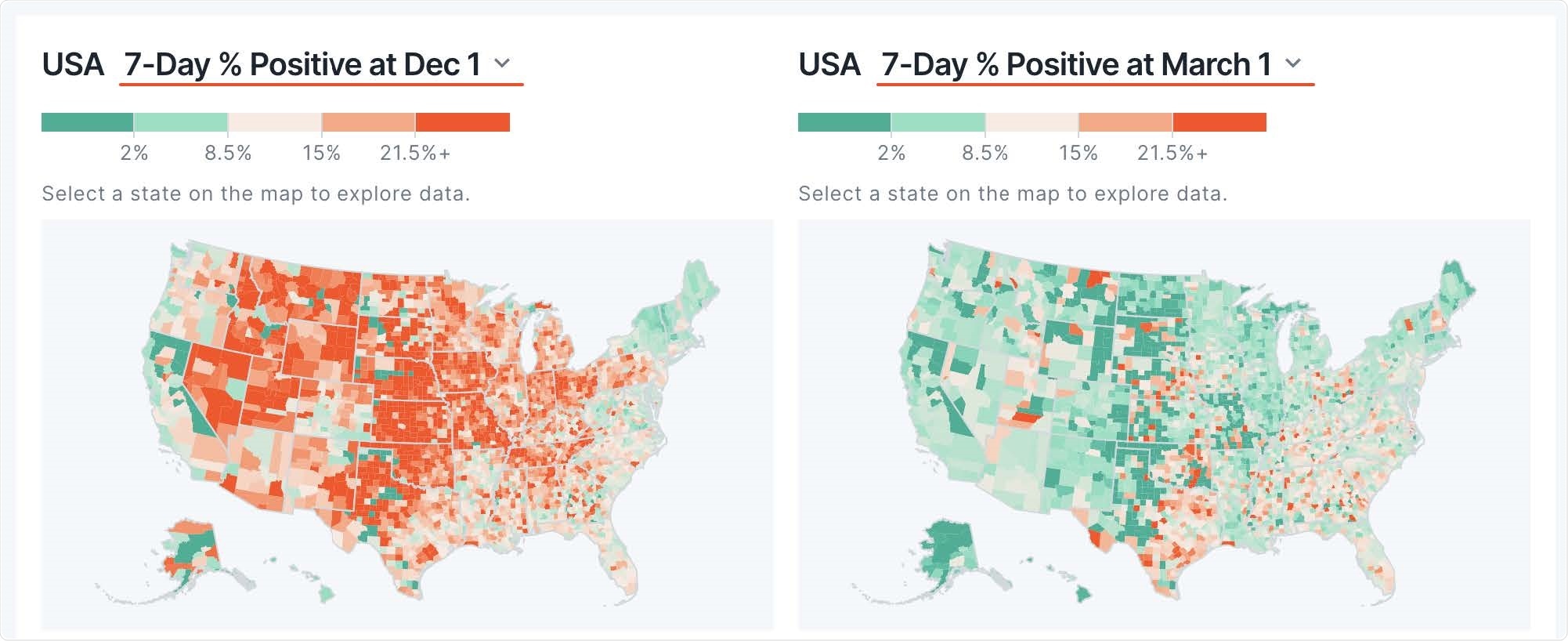By comparing vaccination rates in 580 counties across the United States with the corresponding coronavirus disease (COVID-19) incidence rates, a recent study currently available on the medRxiv* preprint server finds that cumulative county-level vaccination rates are significantly associated with a concomitant fall in the incidence of COVID-19.
As mass vaccination endeavors are spreading around the world in our best attempt to curb the COVID-19 pandemic, there is a dire need for real-time assessment of how vaccination rates (but also other salient factors) actually influence community spread and localized outbreaks.
At the beginning of March 2021, more than 51 million individuals in the United States have been given at least one COVID-19 vaccine dose, including over 26 million people who have been completely vaccinated with both doses of Pfizer/BioNTech (BNT162b2) or Moderna (mRNA-1273) vaccines.
And while phase III clinical trials for the aforementioned two FDA-authorized mRNA vaccines were shown to lower the risk for symptomatic COVID-19, their real-world effectiveness and safety has recently been confirmed with the use of context-rich electronic health records across American and Israeli health systems.
Nonetheless, the impact of vaccination on community transmission of the severe acute respiratory syndrome coronavirus 2 (SARS-CoV-2) remains to be characterized, which prompted a research group led by Dr. Arjun Puranik from the company ‘nference’ in Cambridge, Massachusetts, to explore this exact issue.

Curating data and comparing rates
In order to conduct a comprehensive and real-world analysis of how vaccines exactly impact COVID-19 incidence in the United States, these researchers initially obtained county-level polymerase chain reaction (PCR) testing data, as well as temporal and cumulative county-level vaccination data.
Then they have concentrated on the correlation between two metrics: cumulative county-level vaccination rate (which is the percentage of the county population who were given at least one dose) and December-March change in COVID-19 incidence rate (i.e., the difference in 7-day incidence rates between December 1, 2020, and March 1, 2021).
Moreover, the researchers also performed a separate manual curation of cumulative vaccination rates through March 1, 2021, across 1408 counties from 28 states. A time-delay (or a one-month “gap period”) has also been taken into account for some of the analyses in this paper.

A decline in COVID-19 incidence
This study has demonstrated that cumulative county-level vaccination rates all the way through March 1, 2021, are significantly associated with a consequent decline in COVID-19 incidence, with stronger negative correlations in the Midwestern counties and Southern counties.
Furthermore, all examined regions show significant negative correlations between cumulative COVID-19 incidence rate before the vaccine rollout and the drop in the COVID-19 incidence rate between December 1, 2020, and March 1, 2021 – with the western region of the United States being particularly striking.
Still, the cumulative vaccination rate and incidence rates have to be considered as statistically independent variables, highlighting the need to carry on with the ongoing vaccination roll out at scale.
“Given confounders such as different coronavirus restrictions and mask mandates, varying population densities, and distinct levels of diagnostic testing and vaccine availabilities across US counties, we are advancing a public health resource to amplify transparency in vaccine efficacy monitoring,” emphasize study authors in this medRxiv paper.
Conveying an evidence-based message
In a nutshell, this study accentuates the significance of tying the current vaccine rollout to the real-time observation of spatio-temporal vaccine efficacy in order to help turn the tide of the COVID-19 pandemic. This has to be seen as a data-informed venture, as it will inform strategies in other parts of the world as well.
“Even as people await their turn to get vaccinated, there are reports of subpopulations declining to get vaccinated owing misinformation around the vaccines’ safety and efficacy, which is being amplified through social media,” say study authors.
Still, considering accumulated real-world evidence on the vaccine’s efficacy and safety for those that were vaccinated, this study (and the associated resources) highlights the positive public health effect of the vaccination campaign and additionally motivates global vaccine rollout in order to finally halt the COVID-19 pandemic in its tracks.
*Important Notice
medRxiv publishes preliminary scientific reports that are not peer-reviewed and, therefore, should not be regarded as conclusive, guide clinical practice/health-related behavior, or treated as established information.
- Puranik, A. et al. (2021). Higher COVID-19 vaccination rates are linked to decreased county-level COVID-19 incidence across USA. medRxiv. https://doi.org/10.1101/2021.03.05.21252946, https://www.medrxiv.org/content/10.1101/2021.03.05.21252946v1
Posted in: Child Health News | Men's Health News | Medical Research News | Women's Health News | Disease/Infection News
Tags: Coronavirus, Coronavirus Disease COVID-19, Diagnostic, Efficacy, Health Systems, Pandemic, Polymerase, Polymerase Chain Reaction, Public Health, Research, Respiratory, SARS, SARS-CoV-2, Severe Acute Respiratory, Severe Acute Respiratory Syndrome, Syndrome, Vaccine

Written by
Dr. Tomislav Meštrović
Dr. Tomislav Meštrović is a medical doctor (MD) with a Ph.D. in biomedical and health sciences, specialist in the field of clinical microbiology, and an Assistant Professor at Croatia's youngest university – University North. In addition to his interest in clinical, research and lecturing activities, his immense passion for medical writing and scientific communication goes back to his student days. He enjoys contributing back to the community. In his spare time, Tomislav is a movie buff and an avid traveler.
Source: Read Full Article